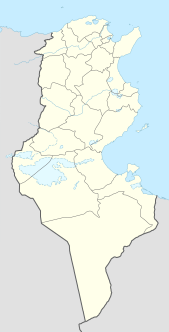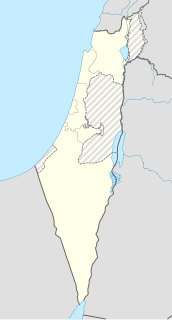
Kairouan Airfield is an abandoned military airfield in Tunisia, which is located approximately 11 km south-southeast of Kairouan, 126 km south of Tunis. It was a major Troop Carrier unit base of the United States Army Air Force Twelfth Air Force during the North African Campaign. Known units assigned were:

Chateaudun-du-Rhumel Airfield is an abandoned military airfield in Algeria, located about 6 km north-northwest of Chelghoum el Aid, in Mila province, about 47 km southwest of Constantine.

Canrobert Airfield was a World War II military airfield in Algeria, located approximately 4 km south of Oum el Bouaghi, approximately 70 km southeast of Constantine. It was used by the United States Army Air Force Twelfth Air Force during the North African Campaign against the German Afrika Korps. The Allied commanders made desperate efforts to prepare forward airfields for the use of fighters and fighter-bombers. Canrobert was one of these intermediate fields.

Rerhaia Airfield was a World War II military airfield in Algeria, located approximately 3 km northwest of Boudouaou, about 32 km east-southeast of Algiers. It was used by the United States Army Air Force Twelfth Air Force 350th Fighter Group between July and November 1943 during the North African Campaign against the German Afrika Korps.

Louis Gentil Field is an abandoned airfield in Morocco, located approximately 6 km north-northeast of Youssoufia, about 170 km southwest of Casablanca.

Souk-el-Khemis Airfield is an abandoned World War II military airfield in Tunisia, located approximately 3 km southeast of Bou Salem, and 110 km west-southwest of Tunis. It was a temporary airfield built by the US Army Corps of Engineers, used by the United States Army Air Force Twelfth Air Force and by the Royal Air Force during the North African Campaign.

Tantonville Airfield is an abandoned World War II United States Army Air Forces military airfield in France, which was located in the Département de Meurthe-et-Moselle approximately 18 kilometres (11 mi) north of Mirecourt and 18 kilometres (11 mi) south-southeast of Neuves-Maisons.

Lecce Airfield is an abandoned World War II military airfield in Italy, which is located approximately 5 km east of Lecce in the Salentine Peninsula. Built in 1943 by United States Army Engineers, the airfield was primarily a Fifteenth Air Force B-24 Liberator heavy bomber base used in the strategic bombing of Germany. Lecce was also used by tactical aircraft of Twelfth Air Force in the Italian Campaign.

Sele Airfield is an abandoned World War II military airfield in southeast Italy, which is located approximately 15 km northwest of Capaccio in the province of Salerno in the Campania region of south-western Italy. It was a temporary field built by the Army Corps of Engineers used as part of the Salerno landings.

Ghisonaccia Alzitone Airport is an airport in France, located 2 km (1.2 mi) north of Ghisonaccia in the Haute-Corse department, approximately 335 km (208 mi) southeast of Corte on Corsica.

La Vallon Airfield is an abandoned World War II military airfield in France, which is located approximately 6 km north-northeast of Montbrison ; about 385 km south-southeast of Paris.

Solenzara Airfield is an abandoned World War II military airfield in France, which is located approximately 31 km north-northeast of Porto-Vecchio on Corsica. It was a temporary airfield used by the United States Army Air Force Twelfth Air Force 415th Night Fighter Squadron between 9 July-1 September, flying Bristol Beaufighters.

Loyettes Airfield is an abandoned World War II United States Army Air Forces military airfield in France, which was located approximately 1 km north of Loyettes, 28 km east of Lyon. It was located at a prewar grass airdrome, which was improved by the XII Engineer Command for military aircraft use. It was known as Advanced Landing Ground Y-25.

Muqeible Airfield is an abandoned military airfield located in the northern West Bank, approximately 1 km southwest of the village of Muqeible, Israel and 3 km north of Jenin.

RAF St Jean was a former military airfield in Palestine, now Israel, which is located approximately 4 km east-northeast of Acre and 100 km north-northeast of Tel Aviv.

El Daba is a village and rail station about 180 km West of Alexandria by road. RAF El Daba is a former Royal Air Force military airfield located approximately 4.6 kilometres south-southeast of the village. El Daba was a pre–World War II airfield, one of a number of DLGs created in the Western Desert of Egypt after the Munich Crisis of the late 1930s. During World War II, it was used as a military airfield by the British Royal Air Force and the United States Army Air Forces during the North African Campaign against Axis forces, and by the Luftwaffe.

Soltane Airfield is an abandoned World War II military airfield in Tunisia, which was located approximately 5 km southeast of Ain Soltane (Sidi-Nsar-Allah); about 170 km south-southwest of Tunis.

Bou Grara Airfield is an abandoned World War II military airfield in Tunisia, which was located near Golfe de Bou Grara (Madanin); about 360 km south-southeast of Tunis.

Landing Ground 174 is an abandoned World War II military airfield in Egypt, east of El Alamein, about 80 km southwest of Alexandria.

Sidi Haneish Airfield is an abandoned World War II military airfield complex in Egypt, in the western desert, about 235 miles (376 km) west-northwest of Cairo.















